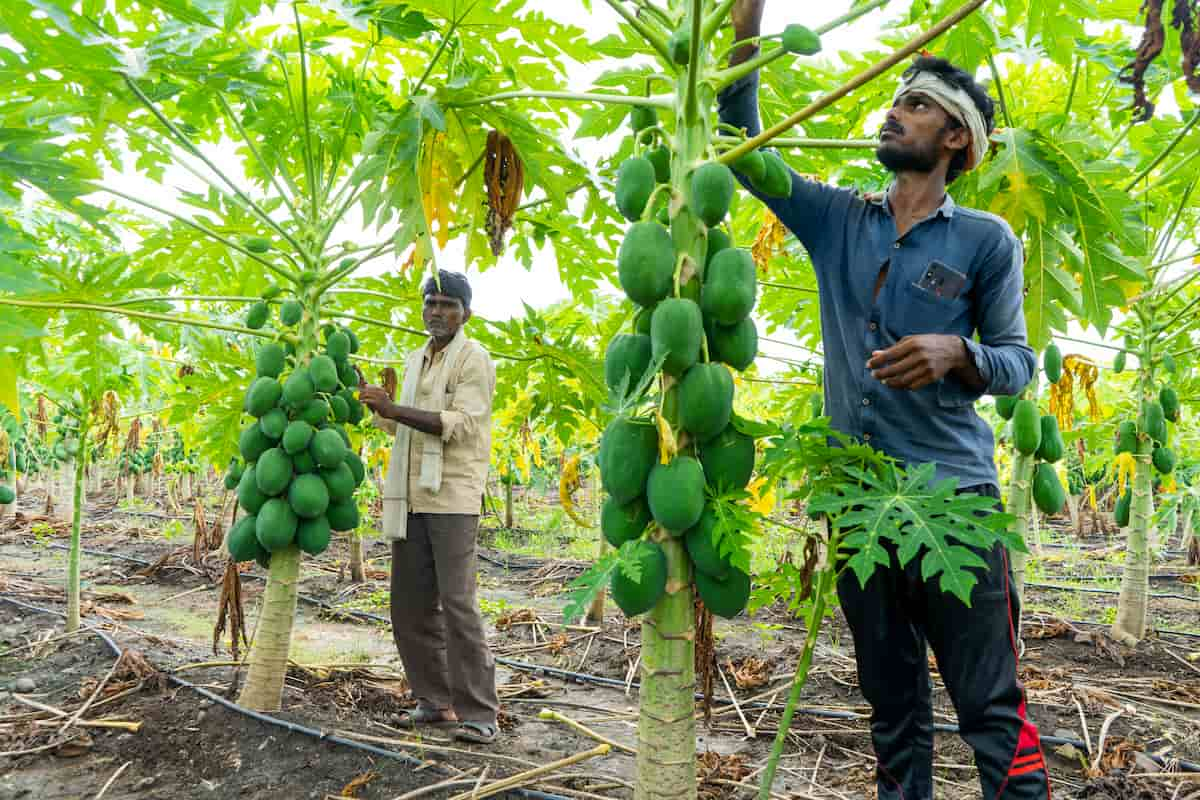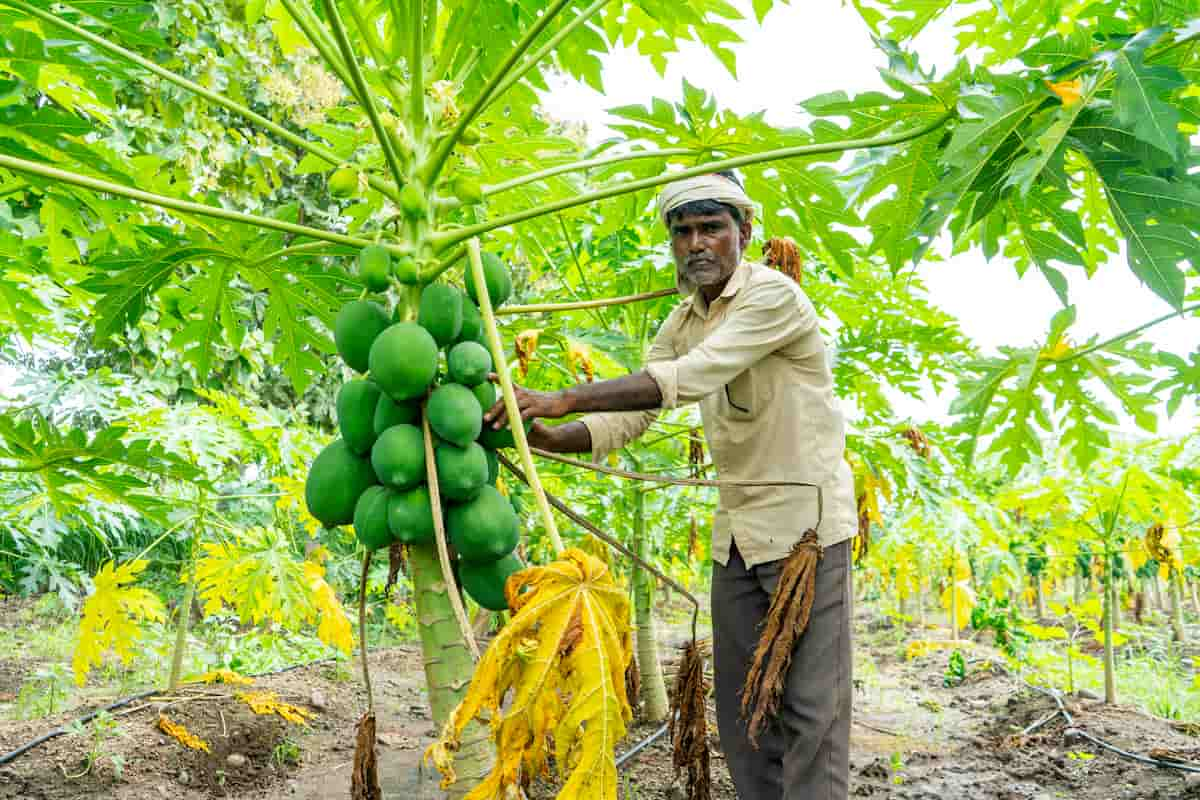Papaya cultivation can be a profitable venture if managed efficiently. However, to maximize profits, it’s crucial to understand the production costs and profit margins of your 1-acre papaya farming project. The production cost of papaya cultivation can range from $4,000 to $9,000 per acre. The main expenses include seedlings, labour, fertilizers, irrigation, and pest control.

Farmers can use organic fertilizers, efficient irrigation systems, and crop rotation techniques to reduce production costs. Choosing the right variety of Papaya can also increase profit margins, as some types have a higher market value than others. With careful planning and management, 1-acre papaya cultivation can yield profits ranging from $10,000 to $20,000 per acre, making it a lucrative business opportunity for farmers.
1 Acre Papaya Cultivation Project Report
Introduction to Papaya Farming
The papaya plant is a species of Carica papaya, and India produced 43% of the world’s supply in 2020. Papayas were first domesticated in Mesoamerica, in modern-day southern Mexico and Central America. The plant is a small, sparsely branched tree, typically growing from 5 to 10 m tall.
Its leaves are large, palmately lobed, and contain latex in articulated laticifers. Papayas are dioecious and have highly dimorphic, five-parted sweet-scented flowers, open at night and wind, and insect-pollinated. The fruit is a large and berry type about 15-45 cm long and 10-30 cm in diameter, ripe when soft and with numerous black seeds attached to the central cavity’s walls.
Market and Demand for Papaya Cultivation
Papaya, also known as pawpaw, is a tropical fruit with a good content of vitamin C and valuable medicinal properties. Originally from southern Mexico, it is now cultivated worldwide. Brazil, Peru, China, Thailand, Mexico, Nigeria, Indonesia, and the Philippines are the next-largest producers of papayas worldwide after India. Papaya is a highly productive and easy-to-grow crop, making it a popular choice for kitchen gardens in India. The demand for Papaya is increasing due to its various health benefits, and it is widely used in the food, beverage, and cosmetic industries.
Papaya is the third most produced tropical fruit globally, with an 11.22 million metric ton production rate in 2010. The global market for tropical fruits, excluding bananas, has increased consistently over the past two decades. Developing countries predominantly produce Papaya, a good source of antioxidants, nutrients, fibre, and digestive enzymes. Asia is the largest papaya producer, followed by South America and Africa. The top-producing countries are India, Brazil, and Indonesia.
Best Papaya High Yield Variety for Papaya Cultivation
- Red Lady: Red Lady is a high-yielding papaya variety widely cultivated for its excellent fruit quality and high productivity.
- Tainung 1: Tainung 1 is a papaya variety known for its high yield and disease resistance. It is also easy to grow and can be cultivated in various climates.
- Maradol: Maradol is a papaya variety that produces large, sweet fruits with red flesh. It is highly productive and resistant to diseases.
- Solo Sunrise: Solo Sunrise is a papaya variety that is highly productive and produces sweet, flavorful fruits. It is also resistant to diseases and easy to grow.
- Honey Gold: Honey Gold is a papaya variety that is highly productive and produces sweet, fragrant fruits. It is also resistant to diseases and can be cultivated in different climates.
Note: Other commercially viable varieties like Coorg Green, Coorg Honey Dew, Honey Dew, Pusa Delicious, Pusa Nanha, Ranchi selection, Solo, Sunrise Solo, and Taiwan.
Best Commercial Package and Practices for Papaya Farming
Papaya farming is a profitable agribusiness venture, particularly in tropical and subtropical regions. The climate, soil, water, and other factors can significantly impact the yield and quality of the papaya crop.
Climate for Papaya Cultivation
- Papayas flourish in high humidity and warmth, making them sensitive to frost and heavy rain. The crop grows best in high humidity but ripens in warm, dry weather.
- Papaya thrives up to 600m above sea level. Papaya grows best in foothills regions. Papaya can be grown in Greenhouse farming.
Soil for Papaya Plantation
- Papaya prefers fertile, lime-free, well-drained sandy loam soil. Papaya thrives in delta and riverbank alluvial soil.
- It cannot grow in shallow or water-repellent soils. Papaya grows in many soils. pH Requirement in Papaya Farming is neutral to near-neutral soil, and pH can be between 5.5 and 7.5.
In case you missed it: How to Grow Papaya in a Greenhouse: A Step-By-Step Guide for Seed to Harvest

The Season for Papaya Plantation
- Papaya is planted during the monsoon, autumn, and spring season.
- The ideal time for planting is during the months of June-July (Rainy), October-November (autumn), or February-March (summer).
Watering Papaya Plant
- Papaya’s water needs depend on light, temperature, rainfall, wind, soil type, etc. Papaya seedlings need irrigation once or twice a week, while fruit-bearing trees need irrigation every 15 days.
- Older trees need plenty of water, but their shallow roots cannot survive stagnation or waterlogging. Drip irrigation is effective for Papaya cultivation at the commercial level.
Crop Rotation and Intercropping in Papaya Cultivation
Papaya is generally crop rotated with sugarcane, bamboo, reeds, etc. Papaya is intercropped with crops like coconut, jackfruit, peanut, pineapple, coffee, etc.
Planting Material for Papaya Farming
- Papayas are commercially propagated through seeds, and tissue culture techniques have been developed but are restricted to laboratories. Papaya seeds cannot be stored for long since they lose their viability quickly.
- The planting material (1700 plants per acre at 1.5 x 1.5 m).
- The seeds are first planted in nurseries in poly bags, and the young seedlings are transplanted after 6-8 weeks.
Land Preparation for Papaya Plantation
- Papaya-growing terrain must be wind-protected and not flood-prone. A month before transplantation, 50cm x 50cm trenches are dug and filled with farmyard manure, organic waste, and soil. When the plants flower, only one plant per pot should be kept.
- For the first year, hoeing prevents weeds. 10% of male plants are left in the orchard after flowering.
Disease and Pest Management in Papaya Farming
Papaya farming faces disease and pest challenges, including ringspot virus, powdery mildew, and aphids. Proper sanitation practices, crop rotation, and disease-resistant varieties can help manage diseases. Insecticides are useful against pests, but only approved products should be used.
Harvesting and Post-Harvest Management in Papaya Farming
- Papaya plants fruit in 6–8 months. Fully coloured and slightly soft fruits are ready to harvest. Overripe fruits spoil easily. Papayas can be cut or picked by hand. Handle fruits carefully to avoid bruising.
- After harvesting, fruits should be washed, dried, and transported in plastic crates or baskets. Overcrowding boxes or baskets can harm and ruin fruits. Papayas last longer when stored around 10-13°C.
Marketing of Papaya
Papayas are in high demand due to their delicious taste and nutritional benefits. The fruits can be marketed both in domestic and international markets. In India, papayas are mainly sold in the northern region but can also be supplied to other areas with proper transportation facilities.
Papaya Farming Project Report: Cost of Cultivation for 1-Acre Papaya Cultivation
Cost of Cultivation for 1-acre Papaya Cultivation
- Land preparation: The cost of land preparation, including ploughing, harrowing, and levelling, will be around $500.
- Seedlings: 2000 to 2500 papaya seedlings will cost around $1000 to $1200.
- Fertilizers: The cost of fertilizers will depend on the type and quantity required. For a recommended fertilizer ratio of 6:2:12, the price will be around $600.
- Pesticides: The cost of pesticides will depend on the type and quantity required. An estimated worth of $800 is required for the complete pest and disease management of papaya crops.
- Irrigation: The cost of drip irrigation for 1-acre papaya cultivation will be around $1000.
Overall, the cost of cultivation for 1-acre papaya cultivation will be around $3900 to $4200(INR 3,20,000-3,70,000). The actual price may vary depending on the location, market demand, labor costs, and other factors.
Total Returns from 1 Acre Papaya Cultivation
The maximum price of Papaya is ₹5000 per Quintal, and the average price is ₹ 2250 per Quintal. The average yield of Papaya varies from 35-40(tons/acre), Assuming the average yield as 37.5 tons/acre
- Total production in quintals = (37.5 tons/acre x 1000 kg/ton) / 100 kg/quintal = 375 quintals/acre
- Total returns at average price in rupees = 375 quintals/acre x ₹2250/quintal = ₹8,43,750/acre($12,000/acre)
- Total returns at maximum price in rupees = 375 quintals/acre x ₹5000/quintal = ₹18,75,000/acre($26,000/acre)
Net Profit from 1-Acre Papaya Cultivation
- Total revenue per acre/Total returns per acre = $12,000 – $26,000 (₹8,43,750/acre- ₹18,75,000/acre)
- Total cost per acre/Cost of cultivation per acre = $3,900 – $4,200(₹3,20,000-3,70,000)
- Total profit per acre = Total revenue per acre – Total cost per acre
- Total Profit per acre = ($12,000 – $26,000) – ($3,900 – $4,200) = -$9,100 to $18,100 (₹6,23,750 to ₹13,05,000)
- Note that the total Profit may vary depending on location, market demand, labour costs, and other expenses.
Challenges and Risks in Papaya Cultivation
- Papaya plants are susceptible to various diseases and pests, which can lead to significant crop losses.
- Papaya cultivation requires careful management of soil fertility, water, and other resources to ensure optimal growth and yield.
- Weather conditions like heavy rainfall or drought can affect papaya production and quality.
- Papaya’s market demand and price can be volatile and subject to fluctuations, which can impact the profitability of cultivation.
- Labour availability and costs can be a challenge for small-scale papaya farmers.
In case you missed it: Frequently Asked Questions About Papaya Farming: Very Well Explained for Beginners

Conclusion
Maximizing profits in 1-acre papaya cultivation requires careful planning and management of resources, such as optimizing plant density and using organic fertilizers, while monitoring market demand and controlling production costs.
- Feed Your Flock for Less: Top 10 Tips to Save on Chicken Feed
- Ultimate Guide to Ossabaw Island Hog: Breeding, Raising, Diet, and Care
- Hatching Answers: The Top 10 Reasons Your Chickens Aren’t Laying Eggs
- Eggs and Economics: Breaking Down the Cost of Raising Backyard Chickens
- Defend Your Greens: Proven Methods to Keep Iguanas Out of Your Garden
- Ultimate Guide to Cinnamon Queen Chicken: A Comprehensive Guide for Beginners
- Ultimate Guide to California Tan Chicken: Breeding, Raising, Diet, Egg-Production and Care
- Ultimate Guide to Marsh Daisy Chicken: Breeding, Raising, Diet, and Care
- 10 Types of Chicken Farming Businesses You Can Start for Profits